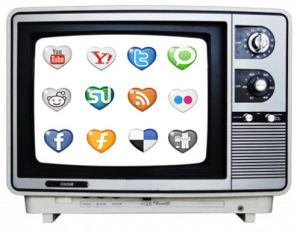Last week I asked audiences on Google+ social media focused communities and followers on my blog to take a short survey about social integration in television programming. I chose to ask these audiences as opposed to my Facebook friends because I felt I would get a more diverse demographic of participants. Seventeen people answered a variety of questions detailing social media’s role in television.
One response that stood out to me the most was how people like to see social media incorporated into their television shows. Over 47% of those who took the survey said they liked to see a Twitter crawl as opposed to a television host reading comments (29%). This was interesting to me because later in my survey I asked what incentive would get my audience to participate in social integrations and over 58% said they would post more if they knew a television host would read their post on air. So what is it they really want? 
82% of my audience believes social media in television programming does add value to their shows, but they generally like it to be done more passively (i.e. via Twitter crawl). I can’t say I disagree. It is nice to be updated about the latest in a certain genre every half hour or so in this fashion, when it interrupts a show or becomes the focal point the show’s message can get lost. I also think social media contests are not as common in programming so the incentive to have a famous person read one of my audience’s social posts is something different than what they are used to seeing!
I found out the majority of my audience likes to interact with their television shows on Twitter (58%). Everyone agreed social media will only continue to play a bigger role in television programming in the future and the majority of my audience supports this (48%). 58% of my audience interact on social media via mobile but surprisingly 0% interact on a tablet (that one threw me for a loop). I expect this statistic to change some in the future as tablets continue to take on a bigger role in our digital world.
Hindsight is 20/20
Overall I am very happy with the results I received, but looking back I would change some things in my survey. I did not ask any demographic questions which I am disappointed about. To be honest I just overlooked these type of questions and really focused on the meat of the matter. I realize now how important demographic questions are because it could help me understand what gender and race like social integration more.
I also wish I would have asked a few questions centered around YouTube. YouTube is vastly popular but isn’t seen much in social integrations on television. Why? I would like to see what my audience’s feelings on this outlet being incorporated into their television shows would be.
I plan to take this information and really think about what it means to me, my career goals and my focus in this degree program. I think if ever presented the opportunity to make a survey about social integration again I have a great outline and now know better, more precise questions to ask my audience.
Hello Alexis. This year Grammy’s integrated user videos, in my opinion, very efficiently. In some of the categories, when they mentioned the nominees, instead of putting a photo, video or music clip of the artist, they put videos sent by the public featuring them singing the nominated song. I wonder if these were YouTube videos. If not, it would have been a great idea to integrate it. However, people could watch clips from the awards ceremony in the Grammy’s YouTube channel.
I’ve seen how people use Twitter to interact with TV shows, particularly to comment while they are watching the show. To me, this represents a distraction, yet it gives people a chance they’ve never had before to interact with others and have more feedback.
About the answer to your question about incentives, I would guess when you add the word incentive to a question, answers change, as was the case in your survey. If one thing is for sure, is that most people agree social media integration adds value to television programming.
I didn’t watch the Grammys this year so I will have to look into how they integrated these videos! I like the idea of user generated videos! I think it could really help give a more personal touch to programming! Sometimes I get distracted by social media in my television programming too but I still like that it is part of the programming! Thanks for your feedback!
I also did a similar survey in which I wanted to know how much people incorporate television programs into their social media posts. As you found, I think Twitter is the most popular platform to engage about these things. It just seems like real-time posts are done more on Twitter, while reactions after the show are more on Facebook.
The trending # topics on the side of Twitter are great, it lets you know exactly what people are talking about, thus making it easier to interact with people about the topic. Social media absolutely adds value, you have your emotions on a program and it’s nice to see how someone else thought of it. Makes the shows more entertaining if you ask me.
I think YouTube could have been in this survey, but at the same time not as much. Meaning that a YouTube video that is was has the feature to be able to be liked or commented on directly on the site. People probably wouldn’t venture away from YouTube to comment on a video since they can do it right on the platform.
Nice post!
Thanks for the feedback Gavin! I really wish I would have included YouTube in my survey! I think you make a good point…it could definitely be incorporated into programming but I don’t know if it would gain traction with interaction between the brand and the audience! I’m glad you find social integration into TV just as interesting as I do!